Medellin to Pereira
While in Colombia, we wanted to visit the main coffee growing region. Called the coffee triangle, the anchor towns for the area are Pereira, Manizales, and Armenia. We decided to stay in Pereira because we’d read that Pereira was like a mini Medellin.
To get from Medellin to Pereira is a 5½ hour bus ride. When we’d gone to Terminales Sur a few days before our desired departure to get bus tickets on the 10:30 am double-decker bus, we got the front two seats on the top level. This turned out to be both good and bad. Good, we had a great view. Bad, we could see everything going on as our driver thought he was driving Le Mans. Over the next 5½ hours, we passed on the left across double yellow lines into blind curves more times than we could count. Sharing the left lane with motorcycles became routine, sharing with cars common, and one time another bus; imagine three buses abreast on two lanes of road. By the time we made it to Pereira, we were emotionally exhausted from waiting to become statistics on the evening news. No one else seemed to be concerned at all, guess it’s normal driving in Colombia, or maybe the driver figured he was the biggest vehicle so no one would mess with him. Did we mention that we’re glad we aren’t driving here?
Sadly, Pereira didn’t make a good first impression, as we passed through some pretty rough looking neighborhoods on our way in to the bus station. While trying to decide whether to walk or take a taxi, we realized that Airbnb hadn’t given us a complete address to our apartment. So while we were trying to figure that out, a few helpful Colombians tried to assist. Which turned into a bit of a circus, as there seemed to be a lot of confusion about Calle 17 vs. Carrera 17. When our well-meaning new best friends started telling Ian not to wear his small backpack because of theft and not to take out his cell phone in the taxi, he started to feel just a bit paranoid. We were finally able to get in touch with our Airbnb host and got the complete address. We took a taxi and were dropped off on the back side of our apartment building.
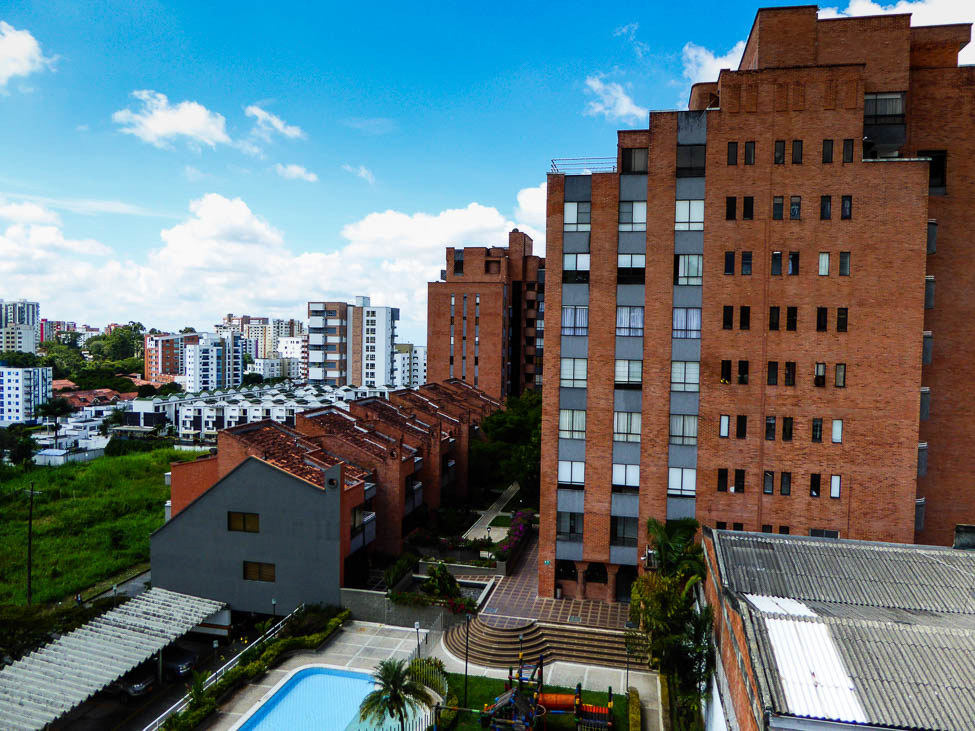
After dropping our stuff in our unit, we decided to go out, pick up some groceries and explore a little. It was starting to get dark, and once again we were warned of theft by some residents standing outside our building. We were beginning to wonder to what kind of place had we been transported. Just as a point of reference, our Airbnb was in one of the three best neighborhoods in Pereira. We ended up having a nice evening exploring the commercial area close to our apartment, finding a mall, groceries, restaurants, etc., and with lots of people out and about. We never felt unsafe that evening, or at any other time during our stay.
The next morning, wanting to give Pereira the benefit of the doubt, we set off to explore the downtown area to see Plaza Simon Bolivar (seems like every town in Colombia has a Simon Bolivar Plaza). We chose our route to stay in the nicer neighborhoods or on main roads. We ended up crossing a couple of neighborhoods that didn’t look great, but with the amount of people around and it being daylight, we reasoned that we were safe, but Ian’s spidey sense was going off so he was extra vigilant. We made it to Plaza Bolivar (this particular one known for it’s statue of a naked Simon Bolivar), took some pictures, and looked in a couple of churches, one of which was different since all of it’s superstructure was make out of wood.
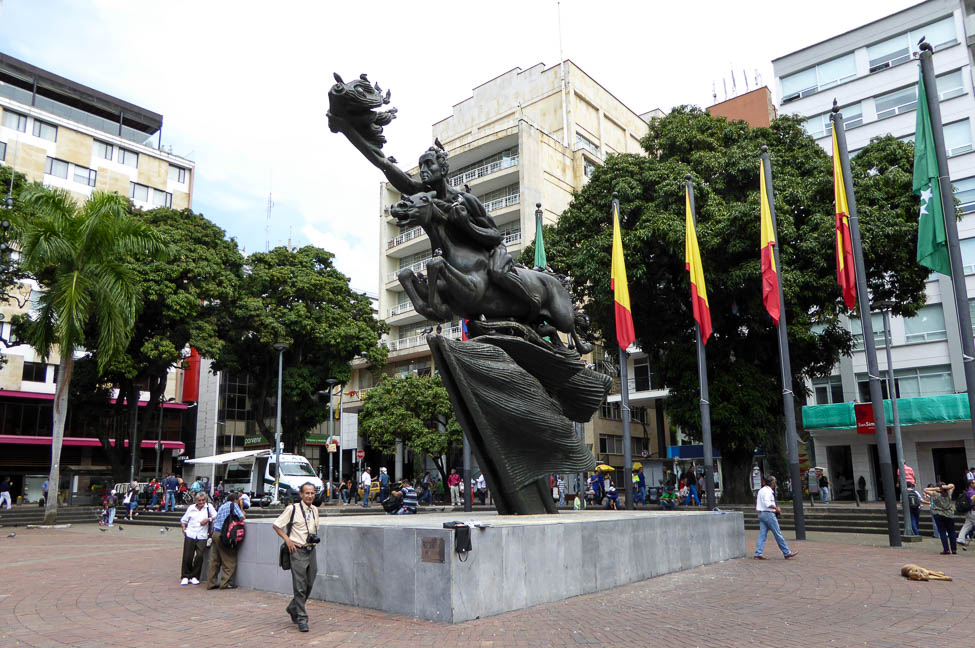
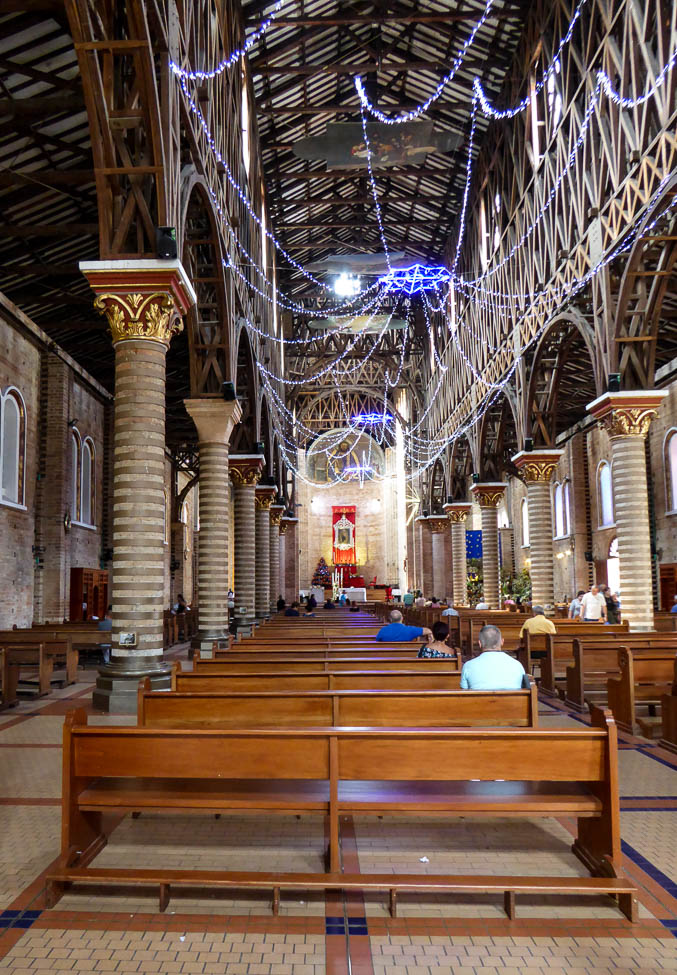
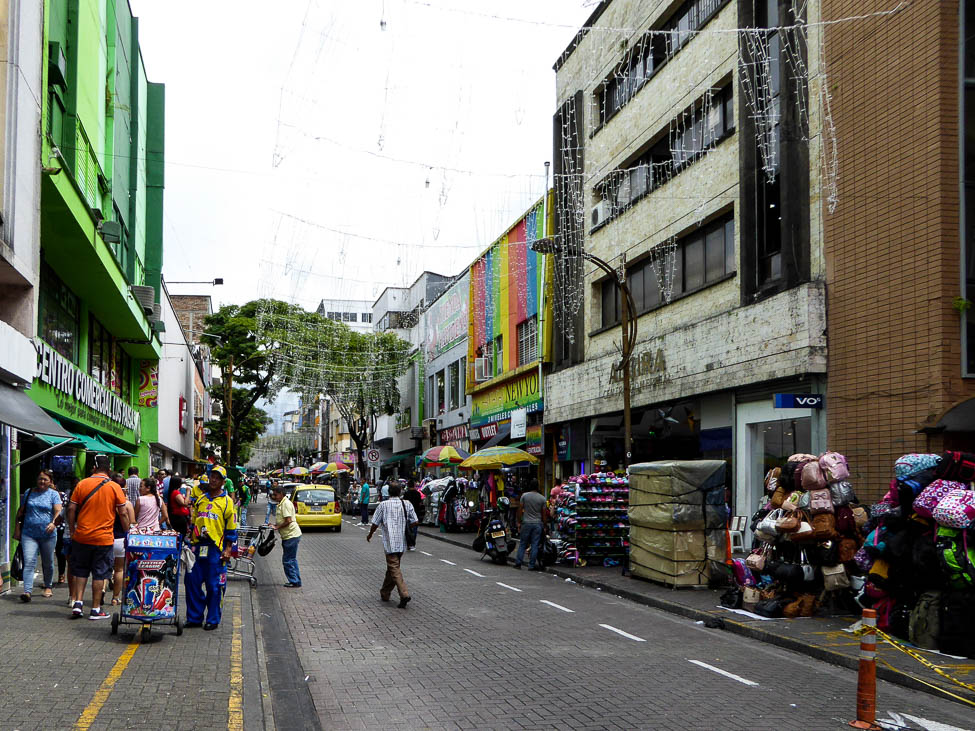
Pereira’s main shopping streetBy lunch time, we turned to each other and agreed that Pereira was not doing it for us. So we decided to change our plan: instead of exploring Pereira as a possible expat destination, we were going to use it as a base to explore neighboring small coffee towns.
The next day being Sunday, we didn’t want to head to the smaller towns thinking that they might be overrun with people from Pereira. So we walked to the bus station so that we didn’t have to rely on taxis. It turned out to be a nice 20 minute walk through our neighborhood of Pinares, and the next neighborhood over, Alamos.
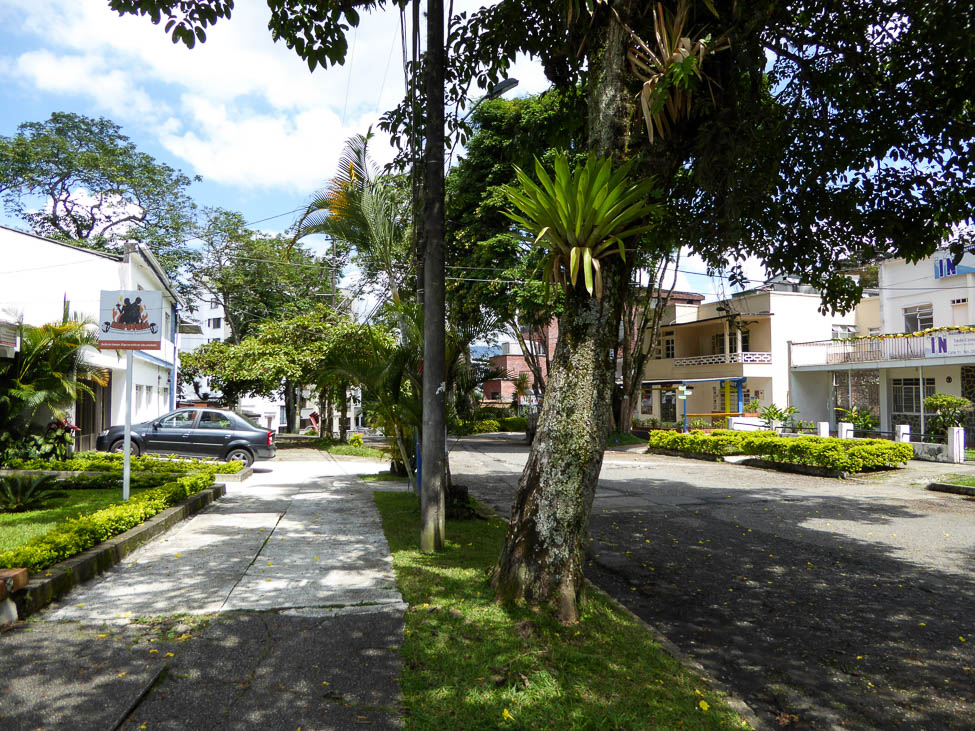
These are two of the nicest neighborhoods in Pereira, and if you are staying in Pereira, we would recommend staying in these areas. As a bit of an anomaly, they are also the closest to the back side of the bus station. Both of these neighborhoods are pleasant and could make a good expat home. Our issue with Pereira is that unlike Medellin which has a steady slope of neighborhoods, i.e., a 6 is a little nicer than a 5 which is a little nicer than a 4, in Pereira, moving down from a 6, it seemed to be like falling off of a cliff. That said, since we had decided that Pereira was not an expat option for us, we didn’t actually put much effort into in-depth exploration.
Filandia
Venturing away from Pereria, our first stop was Filandia, which turned out to be a pleasant, un-touristy town with colorful buildings.
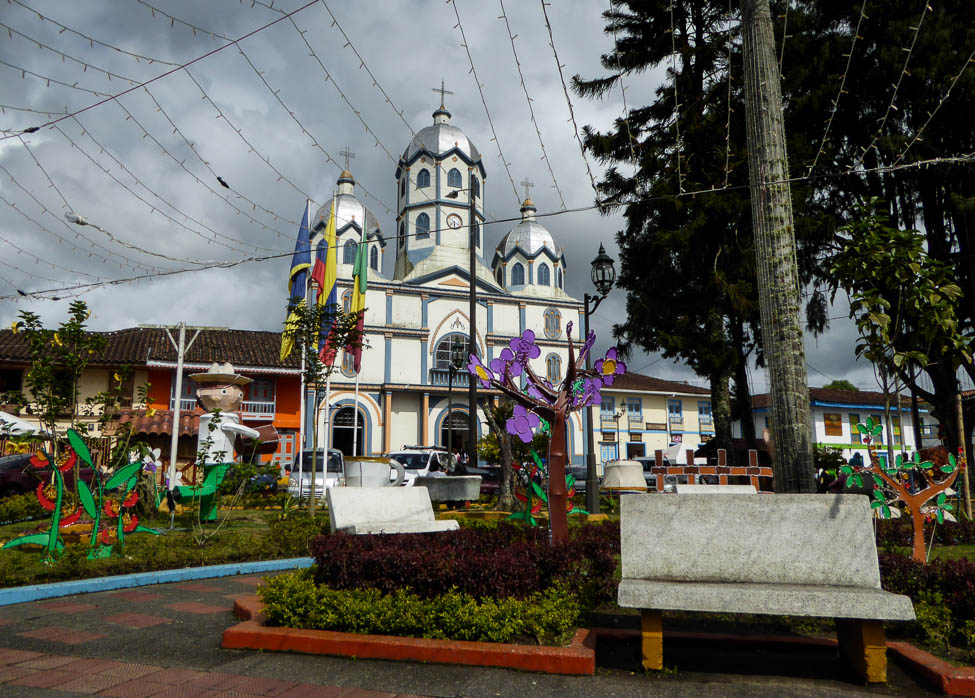
It took about an hour from the Pereria bus station through very scenic landscape. We enjoyed walking around Filandia and are glad that we paid a visit.
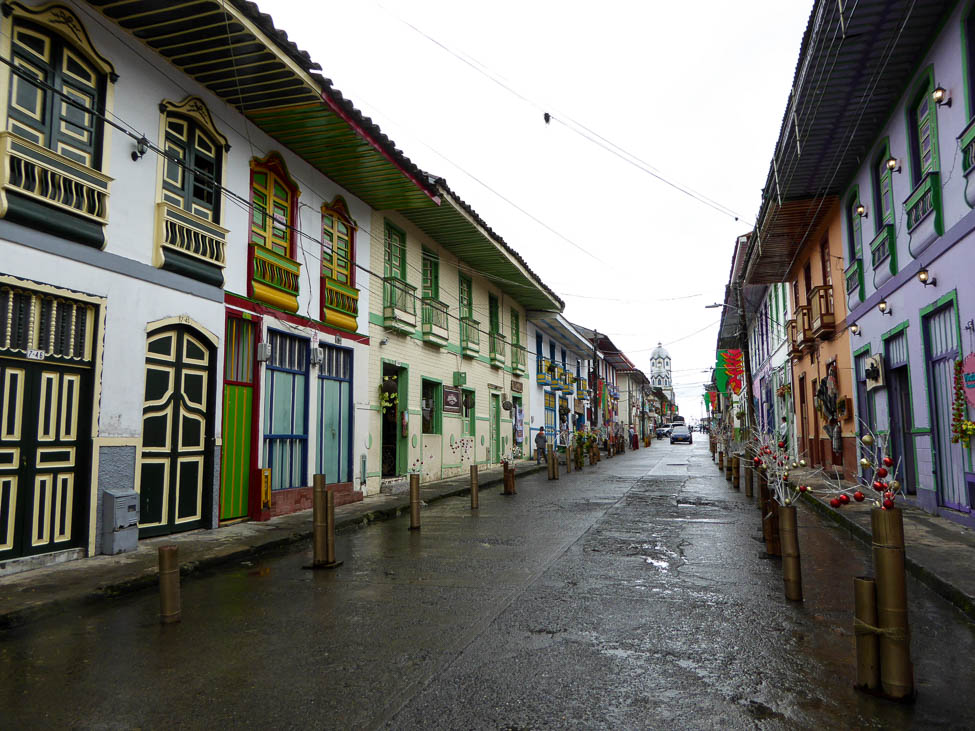
We found a coffee shop, Café Diaz, which served local coffee from a finca in the region, and the coffee was delicious. Two lattes for 4000 pesos ($1.40) – quite the bargain. As far as we know, Filandia has no must see sights and after about four hours, we were ready to head back to Pereira, a pleasant day in the countryside.
Salento and the Valle de Cocura
Salento is a town famous for its colorful buildings and its proximity to the Valle de Cocura. We decided to spend an overnight in Salento (midweek, as we’d been told that the town is packed on weekends) so that we could explore the town and do some hiking in the Valle de Cocura.

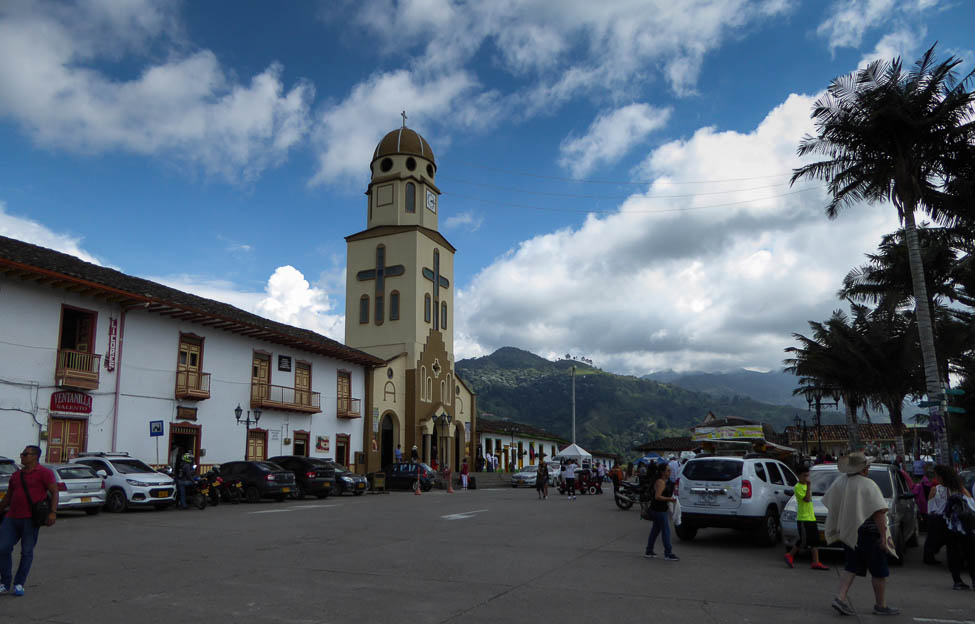
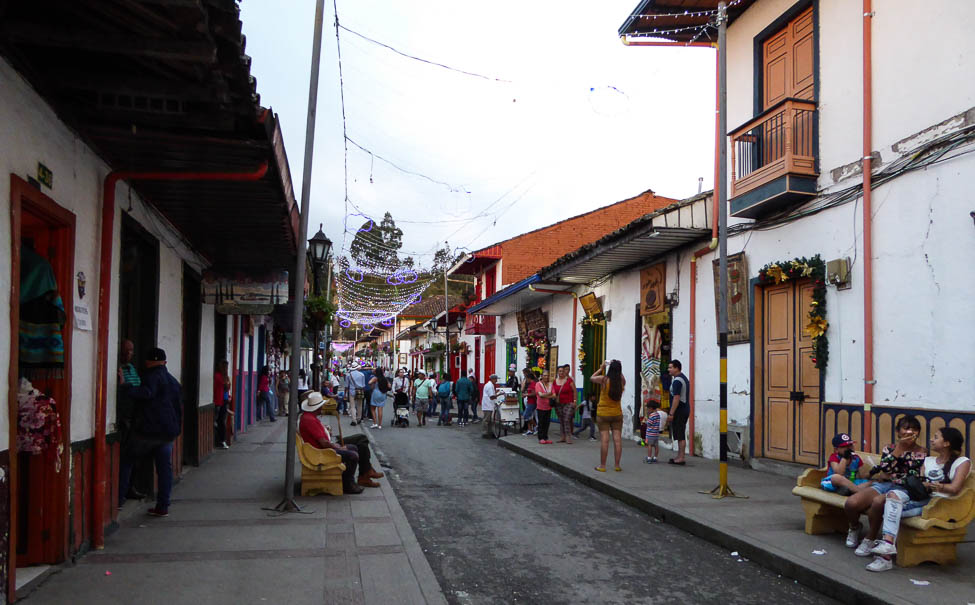
We stayed at the Hotel El Jardin which turned out to be a great hotel two blocks from the main square: clean rooms, comfortable beds, and a great breakfast for about 96000 pesos ($35) a night. We spent the first afternoon exploring town, since we were told that hiking the Valle de Cocura is better in the morning. It is a picturesque town and on a weekday, not too touristy.
The next morning, it was time to go hiking in the Valle de Cocura, an area which contains Colombia’s national tree, the wax palm, which is also the tallest palm tree in the world. (And while there, we also saw Colombia’s national bird, the Andean condor.) To get there, walk to the central plaza and catch a Willy, an old fashioned Jeep that can take about 10 people for 4000 pesos ($1.40) per person . The Willys leave every hour on the half hour, and the ride takes about 30 minutes. If you Google the hike, everyone talks about doing the whole hike which is 7 kilometers and takes 5-6 hours and can be quite strenuous.
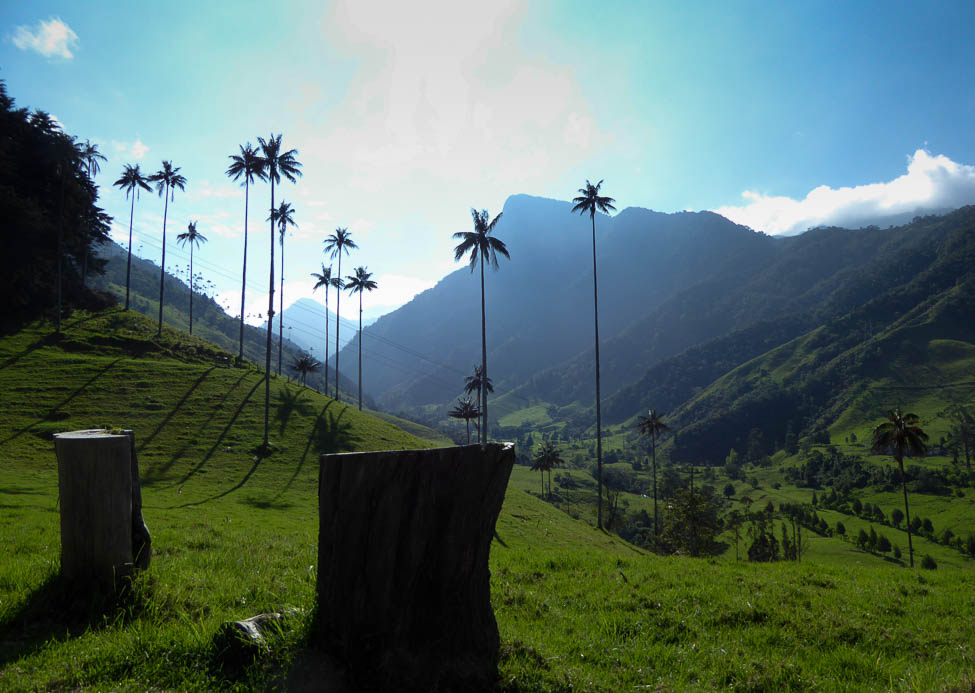
That’s not necessary; even a short distance in, we were seeing the palms . We didn’t have enough time (we had to catch 2 buses to get to Buenavista that evening) to do the whole hike so we went in about 1 1/2 hours and it took about an hour back. In hindsight, maybe we should have spent two nights, so that we could have done the whole hike. The area was stunningly beautiful!
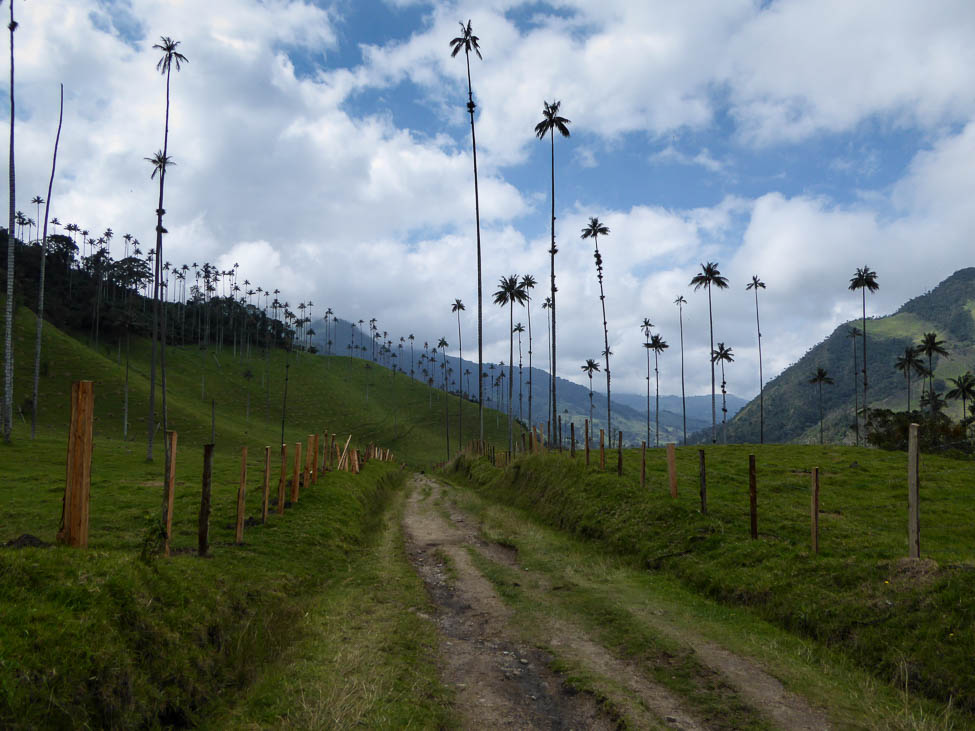


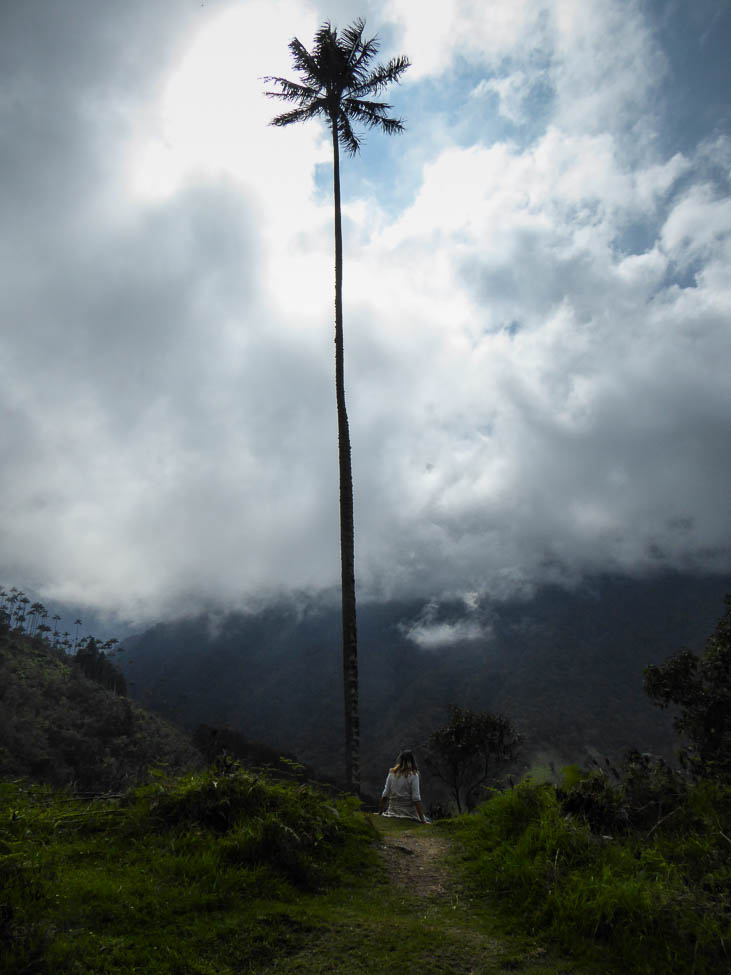
We had caught an 8:30 am Willy and arrived at 9:00 am. By 10:30, it was already starting to cloud up and was getting a little chilly. We had passed only two or three other groups of hikers going in. We probably ascended about 1000 ft when we decided that it was a good time to turn around. By the time we got back to our starting point, there were significantly more people. We can’t imagine how crowded both Salento and the Valle de Cocora would be on the weekend.
Buenavista
When we started planning our visit to the coffee region, we came across an article called the “Best Coffee Tour in Colombia” which described a tour called Wakecup by Experiencia Cafeteria, and we both agreed that we definitely wanted to do this tour. Which meant that we needed to get ourselves to Buenavista, where we opted to stay at the Cafe Panorama Hostel, owned by the same people who run the tour.

The view from the hostel is amazing! The building has a full length patio filled with couches to allow the view to be enjoyed while sipping delicious coffee, as local organic coffee and equipment are provided for guests to make their own coffee as much as desired.

The next morning, we set off on the tour. The cost was 150000 pesos ($50) per person (we were the only ones on the tour and we believe the price drops if there are more people). While it initially seemed expensive, by the end of the tour we both agreed it was well worth it. We started with a ride to Pijao, the next town over, to begin the tour. Our charming and knowledgeable guide was Valentina, who asked if we wanted the tour in English or Spanish. We opted for Spanish with the option of asking for explanations in English. We started off with a walking tour of Pijao (where Valentina lives – we met her grandmother) including a little history of the town and area.


Followed by a visit to the Cooperativa de Caficultores del Quindio. Part of the Federation of Colombian Coffee Farmers (known by it’s Juan Valdez marketing logo), this is where coffee farmers bring their coffee to be purchased if they don’t want to do their own marketing. The coffee is weighed and a sample taken to be graded, which is used to determine how much money the farmer will get paid. Next up was the store owned by the Cooperativa where farmers can get supplies needed to grow and process coffee.

Finally, we walked to Cafe La Floresta where we met organic coffee farmer Don Carlos and his wife.

(Get ready to learn more about coffee than you ever imagined or perhaps even care to know.) We got an overview of his history as a coffee farmer and why he started the coffee shop, in his words “as a way to bring dignity back to coffee farmers”. He explained that when farmers sell coffee to the Cooperativa, they don’t get much more money than what their costs are to grow the coffee. He told us about three different kinds of coffee he makes, the first called lavadera, which is the standard Colombian coffee. With this type, the beans are washed when separated from the cherry fruit before drying. The second type is called honey, where the beans are left unwashed for drying and then aged for six months. The third is called natural; here the beans are not separated from the cherry fruit before drying and are aged for ten months.

Don Carlos told us that he believes medium roast is the best to unlock the coffee flavor without having it taste burned. He explained that the best way to make coffee is using a pour over method and showed us three different systems, the first made in Germany, the second in Japan, and the third in the US. The coffee making proceeded as follows:
- The water is heated to 90-95C, just short of boiling.
- The filter is placed in the holder and is washed with the hot water to get the paper taste out of the filter and also to heat the coffee pot below.
- The coffee is ground to the correct size. Seven to ten grams of coffee for 120-150 grams of water.
- A small amount of water is poured over the ground coffee, the coffee is allowed to absorb the water releasing it’s flavor.
- Then more water is poured slowly over the coffee to finish the process.
We got to taste all three kinds of coffee and we preferred the honey and the natural because they seemed to present more robust aromas and flavors on tasting. We discovered that we are not nearly as good at detecting flavors in coffee as we are in wine. Maybe we just need a bit more practice? We also got to try a quite tasty tea made from the coffee beans.
After our visit with Don Carlos, we boarded a jeep for our 30 minute drive on dirt roads way into the back country to visit with Don Leo, another organic coffee farmer, on his finca.
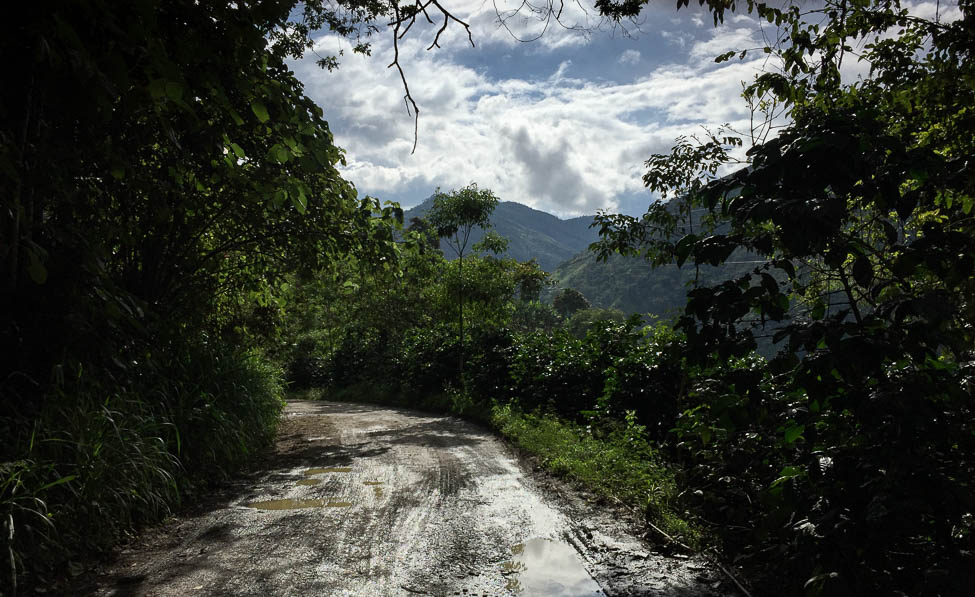
First, we had a delicious typical lunch which was much needed after the buzz we got from our visit to the coffee shop. Then we got to walk through the whole process of growing and making coffee:
- Looking at the coffee bean as it turned into a live seedling.
- Seeing a smaller plant ready to be planted.
- Venturing out into the coffee plants to view an area where Don Leo is growing special coffee with the help of banana trees to provide the right amount of shade.
- Picking some coffee cherries.
- Dunking the coffee cherries into water and picking out the ones that floated to the top because of either no bean in the center or insect damage.
- Separating the cherry fruit from the bean (pergamino) using a special machine.
- Washing the pergamino.
- Drying the pergamino.
- Separating the shell of the pergamino from the almandra, which is the coffee bean ready to be roasted.
- The coffee roasting.
- The grinding of the coffee.
- The making and FINALLY drinking of the coffee.
Don Leo explained that his current finca is his third, and he has been there for seven years. He was displaced from his previous fincas because he was unable to pay the money demanded by paramilitary organizations that were fighting the FARC during Colombia’s times of trouble. He also explained that nothing goes to waste from the coffee making process. The cherry fruit is fermented to make propane, and the left over is used as pig and chicken food and fertilizer for the coffee plants. A truly memorable day and one we would highly recommend!

Next Up: 2017 Expenses
Ian & Ann

18 Comments
I am impressed with all your daring adventures I must admit I am one of those who is a little Leary of traveling in South America so at least I get s taste thru your eyes
Hi Arlene,
The only place we had any real concerns for safety was Pereira, and that could have been because we didn’t particularly like the city and maybe didn’t give it a fair chance. We never felt unsafe in Medellin or any of the small towns we visited.
Ian & Ann
Amazing……I am enjoying your adventures!
Ann you are an amazing storyteller and anxiously await hearing about your upcoming travels!
Hi Carrie,
Actually, we write the blog posts together, but thanks for the compliment.
Ian & Ann
Love your description of the bus trip, sitting near the front and seeing all the crazy moves the bus driver makes! That is true in so many countries around the world!
Such a good decision to take an intensive Spanish language course – comes into use everywhere you go, doens’t it?
Now you will appreciate coffee!
Thanks for sharing,
Karen
Hi Karen,
Yes, we’ve had some pretty crazy bus rides.
And yes, we are so glad we began our travels with Spanish immersion classes. We are often amazed at how much we’ve learned and how much we’re able to have simple conversations, although sometimes we find ourselves at a complete loss. We found this to be the case more often than not in Medellin, where the people speak so fast, and perhaps are using different words.
We have a totally new respect for coffee.
Ian & Ann
Wow! Amazing places you are going and what you are learning.
Robin
Hi Robin,
Yes, we consider ourselves very fortunate, and some of the places we’ve visited have been particularly special to us.
Ian & Ann
Recuerdo visitar una granja en Ibaque y pasar tiempo en Manizales. Tal vez fue Manizales el que recuerdo como una sitio alto con un bello paisaje rural cerca de montañas nievada, tan hermosa como he visto en cualquier parte. Sin embargo, pensé que esa memoria llega de un otro lugar justo al norte del ecuador que yo no puedo encontrar en el mapa.
Desfruten las vistas de paraiso.
Hola Art,
Sabiamos que tu habias viajado mucho en el pasado, pero no nos dimos cuenta tantos paises y cuidades. Gracias por compartiendo tus experiencias.
Ian & Ann
From Cartagena, Mt Santa Marta is a little south east. You can take a taxi to the ski lodge. Great memory. Avoid Barranquilla.
Hi Art,
We are surprised to learn about a mountain not far from Cartagena. We didn’t venture anywhere outside of Cartagena and are now in Mexico.
Ian & Ann
Dear Ann and Ian,As always love reading your reports. The height of the palm trees are unbelievable. Such colorful buildings, and scenery. You both look terrific in the café with Don Carlos and standing with Don Leo and Valentina. Got a great history and info. about coffee. Love
Hi Norma,
Glad you are getting so much out of our posts. If you thought we looked terrific in those photos, you should see us now with our tans after a few days at the beach. 🙂 Maybe, like us, you’ll now drink coffee in a whole new light.
Ian & Ann
I totally agree too! pics and blogs are great!!
🙂
I never knew growing coffee could be so interesting! Thanks for all the great tales.
Ellie
Hi Ellie,
Neither did we! It was a special experience.
Ian & Ann